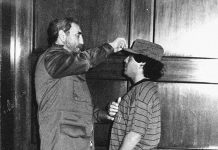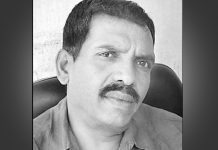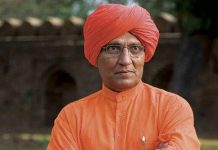Sunderlal Bahuguna is no more.
The veteran environmentalist and chipko movement leader passed away today (May 21) around noon at a hospital in Rishikesh, where he had been admitted about 2 weeks ago following Covid-type symptoms.
Born in a village along the bank of the Ganges river in Tehri Garhwal (presently a district of Uttarakhand) , as a schoolboy he met Sridev Suman , the famous freedom fighter who later sacrificed his life during a jail sentence, and decided to follow his example of a deeply committed social life. He started secretly sending out news relating to Suman and faced police action. He escaped to Lahore but returned when the freedom movement in the Tehri kingdom was beginning to peak. At first stopped from entering Tehri, he joined the struggle somehow and contributed much.
After independence he devoted himself to various social commitments. With his unquestioned honesty and deep commitments he was then the rising star in the social-political life of Garhwal. A marriage proposal from the father of Vimla emerged but his daughter had by then become a disciple of social activist Sarla Behn and was devoted to serve villagers outside the limelight of mainstream politics. She laid down this condition for marriage to Sunderlal that they will serve people together in a difficult rural region. Marriage followed and the couple settled down to serve villagers in Silyara, near Ghanshali, close to Balganga river. Both firmly accepted Mahatma Gandhi as their main teacher and inspiration.
Following the Chinese invasion leading Gandhian Vinoba Bhave called upon Gandhian social workers in the Himalayan region to play a wider social role and so now with the consent of Vimla, Sunderlal started travelling more widely in many parts of Uttarakhand, particularly the Garhwal part. This led to increasing involvement with social and environmental concerns. Both Sunderlal and Vimla were involved in anti-liquor movements and dalit assertion movements which challenged various forms of untouchability. Enduring relationships were established with several younger activists like those in Henvalghati region. Around the late seventies a series of Chipko movement activities centered in Henvalghati region were launched for saving forests like those of Advani and Salet which generated a lot of enthusiasm. The action shifted then to even more remote forests like those of Kaangar and Badiyargad, where Sunderlal Bahuguna went on a long fast in a dense forest area in very difficult conditions. Side by side he maintained a dialogue with senior persons in the government. The prime minister Mrs. Indira Gandhi in particular had very high respect for him. Very big success was achieved as the government agreed to stop the green felling of trees in a vast Himalayan area.
Following this success Sunderlal went on a very long and difficult march from Kashmir to Kohima, including Bhutan and Nepal, covering a vast part of the Himalayan region to spread the message of saving forests and environment with the involvement of people. During this march, taken up in several stages, several times he faced threat to life but did not stop and completed the march.

He emphasized protection of sustainable livelihoods along with protection of environment. He was involved closely in resisting displacement and organizing forest workers. He was also involved in several constructive activities relating to regeneration of degraded forests and promoting organic/natural/traditional farming.
Soon he was in the thick of the movement for avoiding the harmful social and environmental aspects of dam projects in Himalayan region particularly the gigantic and highly controversial Tehri dam project which was being promoted despite being extremely hazardous, as confirmed even by high-level official reports. This proved to be a very long and difficult struggle. Sunderlal Bahuguna left his ashram and camped on the bank of the Ganges river for several months, accompanied by Vimla.
Although this long struggle did not succeed in stopping the high-risk dam, but certainly it spread awareness of these important issues far and wide.
Sunderlal Bahuguna also emerged as an inspiration source for forest protection and environmental struggles in many parts of India and even abroad. In the Western Ghats region, for instance, he was an important inspiration source for the great Appiko movement for saving forests. He was invited to important international conferences and his opinion on environmental issues was widely sought. He was honoured with several prestigious awards, including the Padma Vibhushan.
All his life he worked as a part-time journalist and writer in Hindi and English languages to earn livelihood support. His articles and reports, not to mention interviews with him, have been published in many leading newspapers and journals .Vimla ji told me that she is very keen that at least two collections of his writings published over the years should be brought out.
He contributed to many constructive causes such as the Bhoodan ( gift of land) movement and evolving an alternative development strategy for the Himlayan region rooted in a combination of combining environment protection with sustainable livelihoods.
He spent his last days in Dehradun at his daughter’s home. Last year when I wrote the biography of Sunderlal and Vimla Bahuguna and went to Dehradun with my wife Madhu to present the book to them, he was eager and happy to converse, despite being weak. He was being looked after with great care by Vimla, helped by their daughter Madhuri.
He leaves behind Vimla and three children, Madhuri and two sons Rajiv and Pradeep.
Our best homage to him will be to work for combining environment protection and sustainable livelihoods.
Bharat Dogra had been close to Sunderlal Bahuguna over more than four decades. His recent books include Vimla and Sunderlal Bahuguna—Chipko Movement and the Struggle Against Tehri Dam Project.














